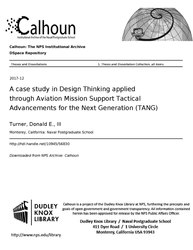File:A case study in Design Thinking applied through Aviation Mission Support Tactical Advancements for the Next Generation (TANG) (IA acasestudyindesi1094556830).pdf

Original file (1,275 × 1,650 pixels, file size: 1.98 MB, MIME type: application/pdf, 186 pages)
Captions
Captions
Summary[edit]
| A case study in Design Thinking applied through Aviation Mission Support Tactical Advancements for the Next Generation (TANG)
( |
||
|---|---|---|
| Author |
Turner, Donald E., III |
|
| Title |
A case study in Design Thinking applied through Aviation Mission Support Tactical Advancements for the Next Generation (TANG) |
|
| Publisher |
Monterey, California: Naval Postgraduate School |
|
| Description |
In November of 2016, over 40 Naval Aviators from various platforms in the United States Navy and United States Marine Corps converged on Defense Innovation Unit Experimental in Mountain View, California, to participate in Aviation Mission Support Tactical Advancements for the Next Generation. For the next four days, participants and facilitators engaged in a design sprint utilizing Design Thinking methods to generate the maximum number of innovative concepts in the area of Aviation Mission Support. By the end of the fourth day, 28 robust concepts had been prototyped and prepared focused on pre-flight, in-flight, and post-flight support. As innovation becomes a higher priority for the Department of Defense, effective tools and processes are needed that allow the organization to innovate from within. This is an examination of the research, execution, and follow-on developments supporting the Design Thinking event explored through Case Study methods. Additionally, the lenses of change theory, design attitudes, and the design mindset are applied to the case to identify unique processes and outputs resulting in otherwise unexplained phenomena. This case study is intended to serve as an examination for Department of Defense leadership to better understand applications of Design Thinking as a means to spur innovation. Subjects: innovation; change theory; design thinking; TANG |
|
| Language | English | |
| Publication date | December 2017 | |
| Current location |
IA Collections: navalpostgraduateschoollibrary; fedlink |
|
| Accession number |
acasestudyindesi1094556830 |
|
| Source | ||
| Permission (Reusing this file) |
This publication is a work of the U.S. Government as defined in Title 17, United States Code, Section 101. Copyright protection is not available for this work in the United States. | |
Licensing[edit]
| Public domainPublic domainfalsefalse |
This work is in the public domain in the United States because it is a work prepared by an officer or employee of the United States Government as part of that person’s official duties under the terms of Title 17, Chapter 1, Section 105 of the US Code.
Note: This only applies to original works of the Federal Government and not to the work of any individual U.S. state, territory, commonwealth, county, municipality, or any other subdivision. This template also does not apply to postage stamp designs published by the United States Postal Service since 1978. (See § 313.6(C)(1) of Compendium of U.S. Copyright Office Practices). It also does not apply to certain US coins; see The US Mint Terms of Use.
|
 | |
| This file has been identified as being free of known restrictions under copyright law, including all related and neighboring rights. | ||
https://creativecommons.org/publicdomain/mark/1.0/PDMCreative Commons Public Domain Mark 1.0falsefalse
File history
Click on a date/time to view the file as it appeared at that time.
| Date/Time | Thumbnail | Dimensions | User | Comment | |
|---|---|---|---|---|---|
| current | 20:15, 13 July 2020 |  | 1,275 × 1,650, 186 pages (1.98 MB) | Fæ (talk | contribs) | FEDLINK - United States Federal Collection acasestudyindesi1094556830 (User talk:Fæ/IA books#Fork8) (batch 1993-2020 #5066) |
You cannot overwrite this file.
File usage on Commons
The following page uses this file:
Metadata
This file contains additional information such as Exif metadata which may have been added by the digital camera, scanner, or software program used to create or digitize it. If the file has been modified from its original state, some details such as the timestamp may not fully reflect those of the original file. The timestamp is only as accurate as the clock in the camera, and it may be completely wrong.
| Author | sjhawtho |
|---|---|
| Short title |
|
| Date and time of digitizing | 09:00, 18 December 2017 |
| Software used | PScript5.dll Version 5.2.2 |
| File change date and time | 07:14, 11 January 2018 |
| Date metadata was last modified | 07:14, 11 January 2018 |
| Conversion program | Acrobat Distiller 11.0 (Windows) |
| Encrypted | no |
| Page size | 612 x 792 pts (letter) |
| Version of PDF format | 1.4 |

